Heart Rate Variability (HRV) & Breathing Training for all:
In the process of setting up the previous Covid HRV study, we looked into a range of existing breathing and HRV Biofeedback Apps. But could not find what we feel is needed for a general population to use easily and regularly to help manage their stress and improve their wellbeing. i.e., people who are not, techie geeks like me, who have dozens of different devices or highly motivated sports people, who spend hours a day trying to optimise every aspect of their training. What we want is something that will help a wide range of people to learn the new habit of healthy breathing.
This is why we are running a “co-design” pilot study and would really like your input, feedback, and wisdom. We believe the research evidence already exists that learning to do diaphragmatic breathing at your resonant frequency (more on this next), has a range of health and mood benefits. But the issue is how to bring this research out of the Lab into the real world, where people have busy lives and competing pressures for their precious time.
Most lab studies either use undergraduates that are required or paid to come into the lab regularly or patient populations with serious issues and who are obviously well motivated to find help. But we believe this very simple training could be helpful for millions of people with just low levels of stress, from our modern lives, but only if people can acquire this new habit.
We have two parts to the study, the first is a one-off ‘Resident Breathing Assessment’ and will take around 35 minutes (this can be spread over several sessions if necessary). The second part is ‘The Daily Breathing Practice’ which simply consists of doing a daily 10-minute breathing practise for 28 days. Then just tell us what you think and feel about your experience.
We must say that this home training program, is not Intended as a medical intervention and if you have any health conditions that could be affected by slow breathing, it maybe a good idea to speak to your doctor before trying this program. Also, if you feel any issues during the assessment or training, please just stop, and let us know if we can help, and have a look at www.mind.org.uk for information and support for anyone living with a mental health issues.
We can communicate with email, text, phone or WhatsApp. Or you can use the ‘chat box’ on the bottom of this page. So, if you have any questions or comments, as you’re doing your daily breathing practise, we would love to hear from you.
Resonant Breathing Assessment
Instructions:
Getting in sync – the first task is to work out the rate of breathing that syncs with your heart rate. As you breathe at slower rates from your diaphragm, your heart rate will increase more as you inhale and decrease as you exhale. At around 6 breaths a minute these changes in heart rate i.e., your Heart Rate Variability, will be in sync with your respiration. The ‘sciency’ name for this magical effect is ‘Respiratory Sinus Arrhythmia’ or just (RSA) and has two wonderful consequences. Firstly, the exhale in particular activates the vagus nerve, which is nestled into the muscle around the sinoatrial node (the heart’s natural pacemaker), sending relaxing messages to the parts of the brain regulating emotions. Secondly when you are in sync, the baroreceptors (that control your blood pressure) are positively affected, which again send messages to the brain and overtime, the gain in the baroreceptor reflex may help reduce high blood pressure.
How to find out your in-sync rate: (Your Resonant Breathing Rate)
The Resonant Breathing assessment will take around 35 minutes. It consists of breathing normally for 5-minutes and 30 seconds, followed by breathing at 5 different rates 7, 6.5, 6, 5.5 and 5 Breaths Pre-minute, again for 5:30 minutes each, while measuring your HRV, (You can try other breathing rates if you want). Then I will compute the HRV for each trial and it is likely that one breathing rate will give a higher HRV than the others. This is YOUR ‘Resonant Breathing Rate’.
You only need to measure your ‘Resonant Breathing Rate’ once and then you should use this rate for all your Breathing exercises. (You are welcome to do the assessment again, if you feel something has changed, but at the moment it is believed that for adults the ‘Resonant Breathing Rate’ is not going to change very much over time).
During the Breathing exercise it is a good idea to lie down or sit up straight with both feet flat on the floor and relax. Then you need to do nice slow diaphragmatic breathing. Do not breathe to deeply, just slowly at the fixed rate for that trial. It does not really matter to much how you breathe just make sure you breathe comfortably at the rate for the trial. (Later you can experiment with different breathing techniques and see if they give you a better score).
The Elite HRV App has a ‘Breathing Pacer’ that can guide you to breathe at a set rate. In the Elite HRV App select the ‘Biofeedback’ button from the menu on the bottom:
But there is a small problem with the ‘Team Dashboard’, I use to collect your data. It does not tell me what your breathing rate was in the Pacer Breathing Trials. The App does record the ‘Inhale’ and ‘Exhale’ rates. So, you need to take a note of which rate you were breathing at, the time and the order you did the trials in and email me this information. (tony@qeeg.co.uk).
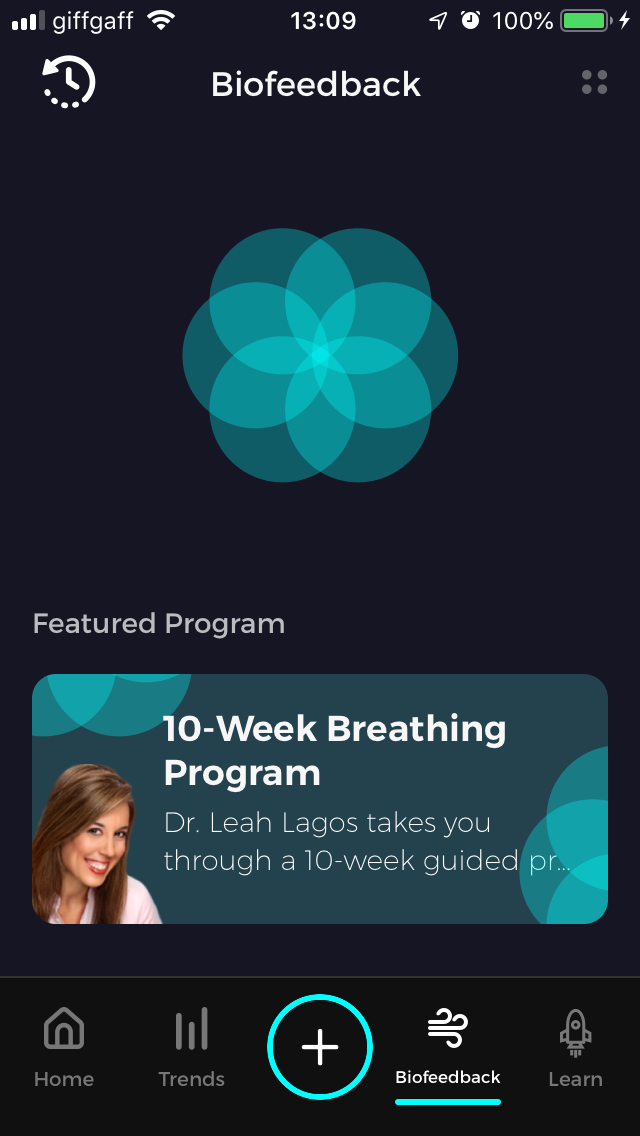
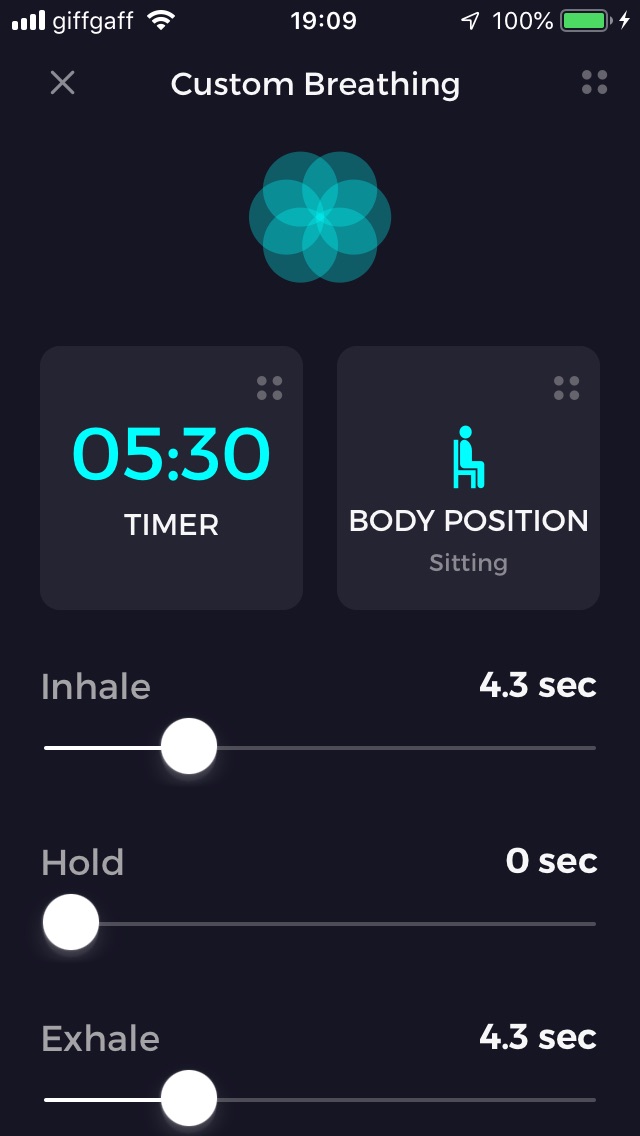
First please set the “Timer” to 5:30 and your “Body Position” to the position you are going the do the breathing assessment in. Then you will need to set both the ‘Inhale’ and ‘Exhale’ rates as follows, for the different trials.
Inhalation & Exhalation Time in Seconds for 3 ratio and 10 Different Rates
Inhalation & Exhalation of 50 / 50
| BPM | Sec Per Breath | Inhale (s) | Exhale (s) |
| 10 | 6 | 3 | 3 |
| 9.5 | 6.4 | 3.2 | 3.2 |
| 9 | 6.6 | 3.3 | 3.3 |
| 8.5 | 7 | 3.5 | 3.5 |
| 8 | 7.4 | 3.7 | 3.7 |
| 7.5 | 8 | 4 | 4 |
| 7 | 8.6 | 4.3 | 4.3 |
| 6.5 | 9.2 | 4.6 | 4.6 |
| 6 | 10 | 5 | 5 |
| 5.5 | 11 | 5.5 | 5.5 |
5 | 12 | 6 | 6 |
| 4.5 | 13.2 | 6.6 | 6.6 |
| 4 | 15 | 7.5 | 7.5 |
| 3.5 | 17.2 | 8.6 | 8.6 |
| 3 | 20 | 10 | 10 |
| 2.5 | 24 | 12 | 12 |
| 2 | 30 | 15 | 15 |
Inhalation & Exhalation of 40 / 60
| BPM | Sec Per Breath | Inhale (s) | Exhale (s) |
| 10 | 6 | 2.4 | 3.6 |
| 9.5 | 6.3 | 2.5 | 3.8 |
| 9 | 6.7 | 2.7 | 4 |
| 8.5 | 7 | 2.8 | 4.2 |
| 8 | 7.5 | 3 | 4.5 |
| 7.5 | 8 | 3.2 | 4.8 |
| 7 | 8.5 | 3.4 | 5.1 |
| 6.5 | 9.2 | 3.7 | 5.5 |
| 6 | 10 | 4 | 6 |
| 5.5 | 10.9 | 4.4 | 6.5 |
5 | 12 | 4.8 | 7.2 |
| 4.5 | 13.3 | 5.3 | 8 |
| 4 | 15 | 6 | 9 |
| 3.5 | 17.1 | 6.9 | 10.3 |
| 3 | 20 | 8 | 12 |
| 2.5 | 24 | 9.6 | 14.4 |
| 2 | 30 | 12 | 18 |
Inhalation & Exhalation of 1 / 2 (i.e., 33/66)
| BPM | Sec Per Breath | Inhale (s) | Exhale (s) |
| 10 | 6 | 2 | 4 |
| 9.5 | 6.3 | 2.1 | 4.2 |
| 9 | 6.6 | 2.2 | 4.4 |
| 8.5 | 7.1 | 2.4 | 4.7 |
| 8 | 7.5 | 2.5 | 5 |
| 7.5 | 8 | 2.7 | 5.3 |
| 7 | 8.6 | 2.9 | 5.7 |
| 6.5 | 9.2 | 3.1 | 6.1 |
| 6 | 10 | 3.3 | 6.7 |
| 5.5 | 10.9 | 3.6 | 7.3 |
5 | 12 | 4 | 8 |
| 4.5 | 13.3 | 4.4 | 8.9 |
| 4 | 15 | 5 | 10 |
| 3.5 | 17.1 | 5.7 | 11.4 |
| 3 | 20 | 6.7 | 13.3 |
| 2.5 | 24 | 8 | 16 |
| 2 | 30 | 10 | 20 |
Once you have set the “Timer”, “Body Position” and entered the inhalation and exhalation time for the trial, select ‘Live Preview’
You will be presented with a ‘breathing pacer’. The circle will expand and contract at the respiration rate you have set, so just relax and get comfortable and breathe in and out slowly from your diaphragm, do not try too hard and if you get dizzy just stop as this is not the rate for you.
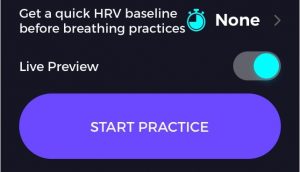
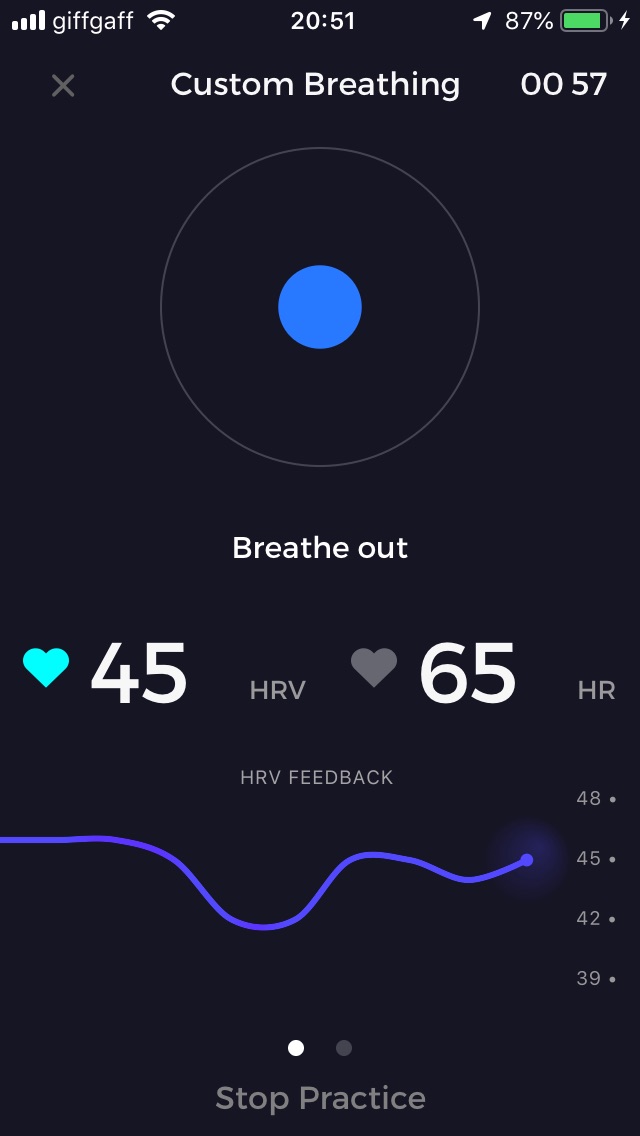
When you finish the breathing trial, save it and the App will give you your HRV score for this rate. (I will also compute the scores from the data I collect on the dashboard).
The breathing trial with the highest HRV is your resonant breathing rate.
Well done.
The Daily Practice
Most of us have learnt bad breathing habits during our lives, with shallow breathing from our chest and we have lost the art of deep breathing using our diaphragm, the muscle that separates the lungs from the abdomen. Given we breathe in and out on average around 25,000 times a day, it would make sense to get it right and stay healthy.
Here's how to do it:
- Lie on your back on a flat surface (or in bed) with your knees bent. You can use a pillow under your head and your knees for support, if that’s more comfortable or sit in a chair (feet flat on the floor), with your knees bent and your shoulders, head, and neck relaxed.
- Place one hand on your upper chest and the other on your belly, just below your rib cage.
- Breathe in slowly through your nose, letting the air in deeply, towards your lower belly. The hand on your chest should remain still, while the one on your belly should rise.
- Tighten your abdominal muscles and let them fall inward as you exhale. The hand on your belly should move down to its original position.
The objective is to learn a new habit of breathing slowly and comfortably from your diaphragm, and achieve automaticity, so you do not have to think about breathing in the new way. But it should not be hard work and you should definitely not get dizzy. You may feel you lose concentration and forget to follow the breathing pacer so just focus your attention on the circle and use it to guide your breathing.
(These are only recommendations, that are likely to help most people. But it is important that you find a method that works for you. We don’t want to be prescriptive about this, after all, we know it’s “Different (Breath) strokes for different folks”).
Time of Day:
Find a quiet time in the day that you are going to use for the training. The time of day affect from the circadian rhythm, does have an impact on your HRV, so it would be useful to try and do the training at a regular time of day and of course this will help create a habit of a regular bit of “ME TIME”.
But we know, we all have very busy lives, and we realise this will be difficult to achieve, so it’s more important to do the training whenever you can. Whether you are a ‘morning lark’ or a ‘night owl’ it is important to find a time of day that works for you. Ideally a time where you can switch off from the world and not be disturbed for 10 minutes while you focus on your breathing and creating a new habit.
It should be noted that the EliteHRV app. is mainly design for taking the daily HRV measurement and it does not have great biofeedback displays. So, the most useful screen to use when you start your custom breathing is the HR display, that plots each heartbeat as it speeds up and slows down. You want to try and create as big a wave as possible with your Heart Rate increasing as you inhale and decreasing as you breathe out.
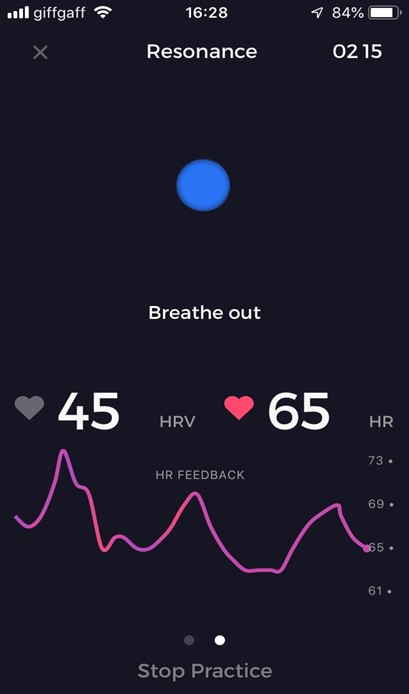
If you want to listen to music as you go, please do, just watch the breathing pacer at the top of the screen and your HRV wave increase and decrease at the bottom.
Just doing the slow diaphragmatic breathing for 10 minutes a day should be good for a wide range of stress related issues and help you build a new normal breathing pattern. But there are two other ways you can also use this technique with acute stressors.
For example, if you have just had an upsetting or stressful event, you can use the breathing technique to try and recover more quickly. We all know this would be a bad time to respond so if you can withdraw from the situation and find a quiet place for a couple of minutes to do the breathing, this could help you avoid making angry or stressful responses.
Also, if you know you are about to have a stressful event, like giving a presentation. You can do the breathing for a few minutes before the task, this should help reduce your stress levels and give more “headroom” when the stressor starts. If you can make this new breathing technique automatic, this should increase your resilience to the stresses of everyday life and allow you to concentrate more and make better decisions both at work and home.
If you have any questions or problems with the App. or hardware, just contact me, any time. ![]()
All the best on your journey to a new habit.
